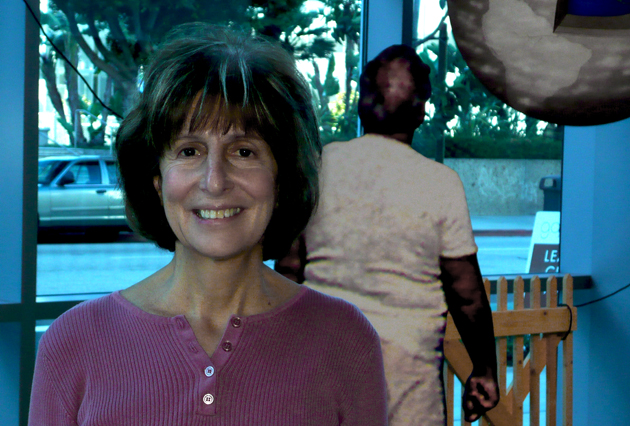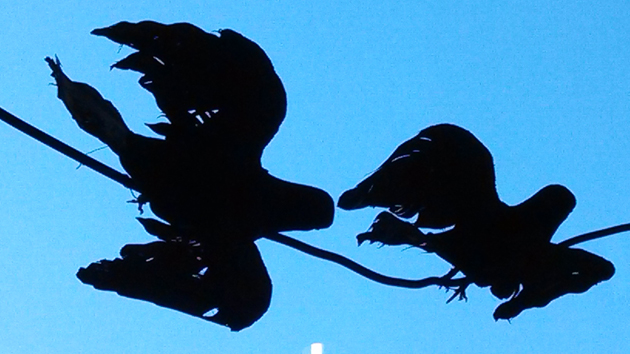
This Friday evening, the Arts Council for Long Beach is hosting an opening reception at The Collaborative Gallery for Place and Time, an exhibition which features work by this year’s Professional Artist Fellows. These artists are being recognized for their artistic merit and professional achievement. Jeff Rau, Shyamala Moorty, Hiromi Takizawa, Patrick Williams, and Terry Braunstein are the artists being celebrated.
I’ve been wanting to interview Braunstein for ages. Her work is all over the area, in bus stations, in the Port and in front of the Cerritos Public Library. Her public art is always site specific, with both scale and content carefully crafted to match the needs of the project.
She’s had solo exhibitions all over the world, and across the United States. Locally, her work has been exhibited in the Armand Hammer Museum of Art, the Los Angeles County Museum of Art, the California Museum of Photography in Riverside, CSULB’s University Art Museum and the Long Beach Museum of Art.
Her work has its roots in photomontage, but she’s embraced both computer and materials technologies, which has found her expanding the media she works in. We started our conversation by talking about her sense of perspective as she considers her whole body of work.
“That’s a difficult thing to do, since artists are always in the middle of something new—or most of the time, anyway—and it is hard to reflect back over the years. I had a show a few years ago that was a twenty-five year retrospective and, at that time, I was able to see many more connections in my work than ever before. I have been working in photomontage since the Seventies, even though it has taken the form of photography, assemblage, sculpture, public art, and installation. There are a few questions that have been of constant interest to me: Time, and the passage of time, passages—the different stages of life, what they represent, how we see ourselves, and how others see us. There are many other insights, of course, that have to do with the nature of being an artist and what that means.
“I have found that I make art to find out the answers to questions. Something is troubling or fascinating or just interesting to me, and I want to know more about it. So I start with all kinds of ‘research’—both visual and literary—and start to collect things that are all ‘clues’ to understanding this question. The work evolves from this, and, at the end, if the work is successful, I have some kind of an answer! Wanting to show, when the work is done, I have come to realize, is for the sharing of this answer. The answer doesn’t even feel as though I came up with. It feels more like the answer just came through me as I created the work. The need to just be in the studio, working, even when nothing comes out of it, is really so that you are there, and ready, when the ‘answers’ start to come.
“You have to remind yourself of the process: Lateral and focused thinking. Then there have been times, of course, as in every artist’s life, when I have thought I would never come up with anything profound to say ever again. I have been there a number of times in my life. Then I have to go back and read Rollo May’s the Courage to Create, so I can remember. There are also the other balances one has in one’s life, between family and work, and all the rest of what it takes to live in this world.”
In her work, Braunstein uses photographs she creates herself, but also draws on the vast collection of images that have been taken since the process was first made available to the public.
“The really compelling thing for me about photomontage is that I love that there are so many millions of photographs in the world already, and that each of them is filled with meanings. They become a kind of palette for me, each image containing the potential for something greater than it is when it is combined with other images. This has been consistent, even as I have moved through different media.
“I started working with the computer in 1994, when I decided to create a book that was commissioned by the National Museum of Women in the Arts. I learned Photoshop as I worked on this book. I found that, for the first time, I didn’t have to find the exact size image or the exact color image to make my photomontage work—I could make these changes in Photoshop. This expanded my world enormously. However, I think that this ability just pushed me further into experimenting all the more with the images once they came off the printer, and that’s when the sculpture, video, installation and public art began.”
One of Braunstein’s works that I truly love is the massive book she created for the Cerritos Public Library, located on the corner of Bloomfield and 183rd, created to celebrate the city’s 50th anniversary. She shared some insights into its creation.
“This was a difficult process, since I was working with a committee from the City. Some of them wanted a ‘scrapbook’ of images of Cerritos historical events, and I had to constantly explain that I was an artist and that they didn’t need me for that. Fortunately, there were enough people on the committee that understood this, so I was able to make an artist’s book out of it. This had been my dream for some time, since I had been working on small sculpted artists books for about 15 years, when I received this commission.
“In these books, I combine many different media, so I wanted to do the same for this project. Eventually, I used Byzantine mosaic, glass, and stucco to create each page, and the doors and windows are large enough so viewers can look and walk through them. In this piece, I wanted to deal with the many things that have made the City of Cerritos work by using images of the Tree of Life and figures from art history to involve the viewers in a deeper emotional way. What I had to do was basically treat the work as I would one of my artist’s books, while simultaneously trying to make a direct connection through recognizable images for the people from the City. This is what I have tried to do in all of my public art.”
The large work Braunstein included in the exhibition at The Collaborative is a great example of her mixed meda montage approach. It combines photographic, sculptural, and installation components.
“I created it for a twenty-five year retrospective that I had at El Camino College three years ago. Garbage-can Man was actually part of another installation called Time Bound. This work consisted of eight vignettes, each about one foot long that all dealt with ageing. I was thinking about what happens to people in the latter stage of their lives, and created these little scenes as investigative works. The Garbage-can Man was particularly interesting to me, since he was in his yard, prevented from leaving by all the ‘trash’ in his life—he was stuck in it. Outside his gate was the entire world with all it offered.

“I had made two installations for LACMA, in their Windows on Wilshire series – when LACMA first took over the May Company – and I loved the change of scale, making my work into something big! When Jeff went through my work, he was intrigued by the idea of an installation in the window space. Of course, it changed a lot as it moved into the Collaborative—it is smaller, and there are fewer wires and birds as a result. But my favorite change is that, at El Camino, the man is really just seen from the ‘front’ of the installation. Whereas at night, when driving down Broadway, you can see the man from the other side, and he is looking outside of his yard into the exhibition. It takes on another meaning, which I love. I also like Jeff’s other choices for work to go with this piece. Transcendance is the four-piece sculpture that is about the expansive experience of Meditation, which works so well with the idea of being Time Bound. And the book is about space and time—the mundane and the universal.”
Like so many artists who live and work in Long Beach, Braunstein appreciates what the city has to offer, but also recognizes opportunities for improvement.
“I have lived in Long Beach for the past 27 years, and feel that this is a city that has a tremendously vibrant art community. I think there is far too little effort made to publicize many of the things we do. So much goes on here that is never known outside the city. Hidden away in studios, across the different areas of the city, are many truly wonderful artists. The universities, museums, theaters, and opera all make this a place that could attract visitors, and it could become a first-class arts attraction to the rest of the country.”
—
The Collaborative is located at 421 West Broadway. The gallery is open from Wednesday through Sunday, from 11AM to 5PM. Two hours of free underground parking is accessible from 3rd Street. Validation is required.
To learn more about The Collaborative, visit ArtsLB.org.
To learn more about Terry Braunstein, visit TerryBraunstein.com.
{FG_GEOMAP [33.7695869,-118.19694129999999] FG_GEOMAP}

